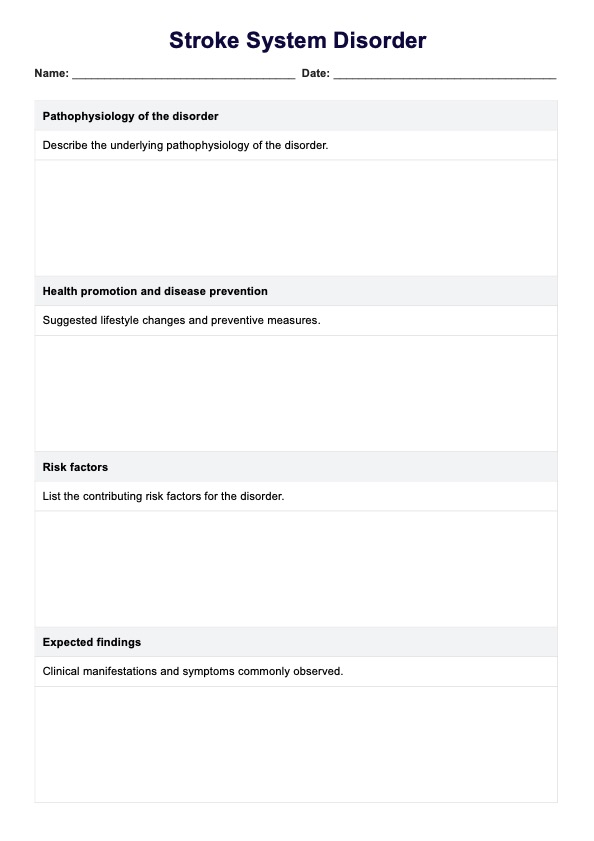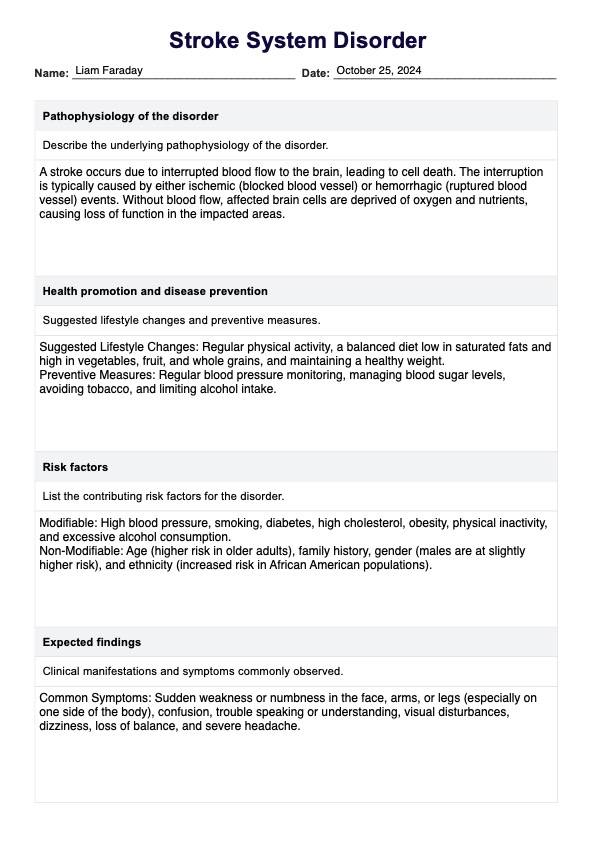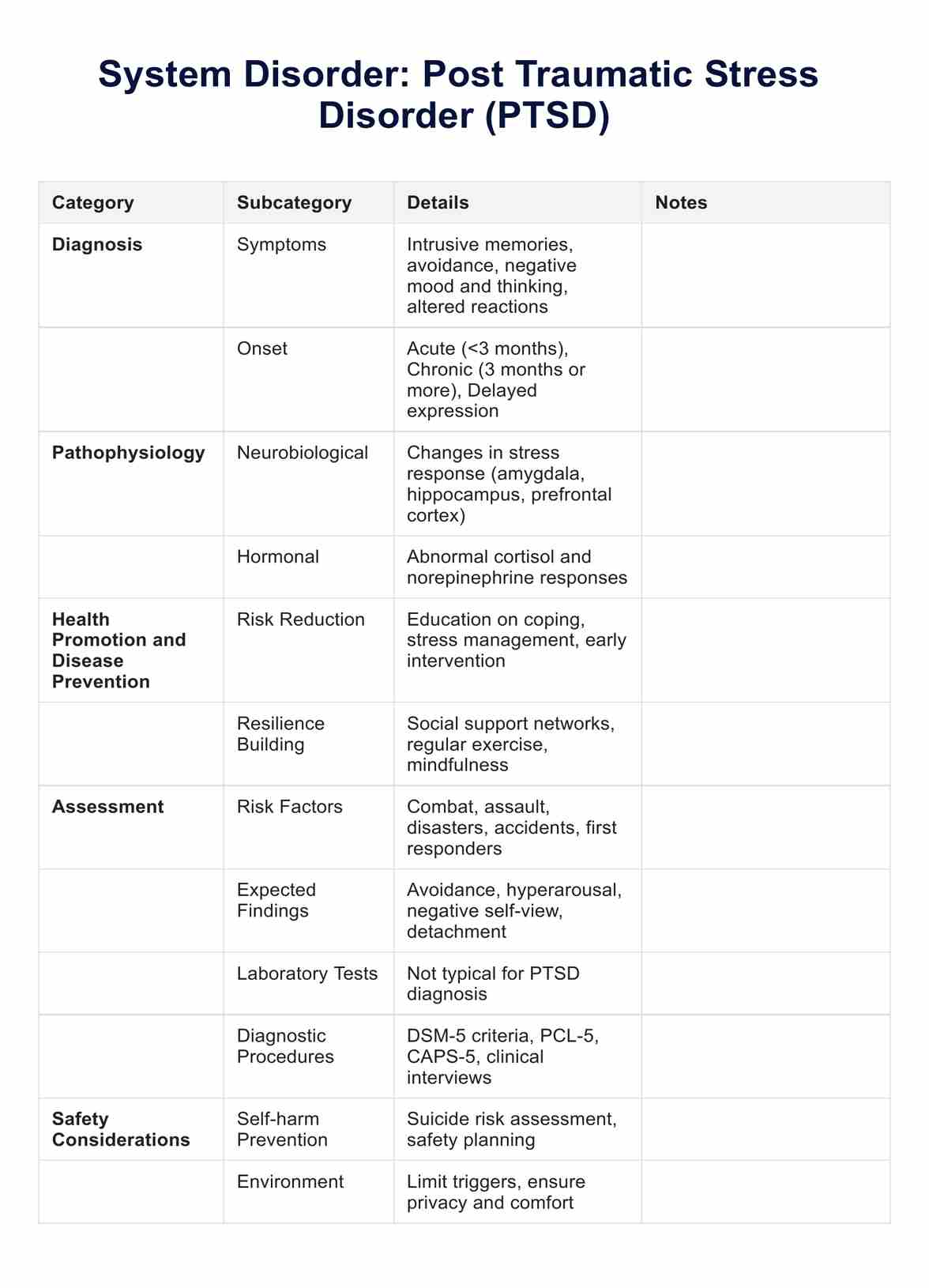Stroke System Disorder Template
Enhance learning with our Stroke System Disorder Template. Use this essential educational tool to improve patient care.


What is a stroke?
A stroke, also known as a cerebrovascular accident or brain attack, occurs when the brain’s blood supply is interrupted, causing brain cells to die. The types of strokes are:
- Ischemic stroke (clots): This is the most common type. Ischemic stroke occurs when blood vessels in the brain are blocked by blood clots, leading to a loss of blood flow to brain tissue.
- Hemorrhagic stroke (bleeds): This happens when a weakened blood vessel bursts, causing bleeding in the brain, often due to high blood pressure.
- Transient ischemic attack (TIA): Known as a "mini-stroke," this is a temporary blockage of blood flow, serving as a warning for future strokes.
- Cryptogenic stroke: A stroke with no identifiable cause, often linked to undetected blood clots.
- Brain stem stroke: Affects the brain stem, potentially leading to severe disabilities, including a “locked-in” state.
Understanding stroke prevention and managing blood pressure are key components in reducing stroke risk.
Stroke System Disorder Template
Stroke System Disorder Template Example
What is a Stroke System Disorder Template?
A Stroke System Disorder Template, an educational resource based on Assessment Technologies Institute (ATI) templates, is a practical tool for students and healthcare professionals to guide them about stroke assessment and management.
It offers a structured framework for evaluating stroke types, identifying risk factors and symptoms, and understanding treatment approaches. This helps students and healthcare professionals develop the skills needed to provide thorough, patient-centered care. Such templates help streamline care, guiding practitioners through stroke management based on current clinical guidelines, like those from the American Stroke Association.
How does it work?
The template guides healthcare professionals through key components such as the pathophysiology of the stroke, clinical findings, and stroke prevention measures. It emphasizes identifying stroke risk factors such as high blood pressure and managing both hemorrhagic and ischemic strokes. Here's a step-by-step guide to accessing and using this template:
Step 1: Access the template
You can download the template using the link provided in this guide, or if you have an account, log in to Carepatron, navigate to the Templates section, and click "Use Template" under the Stroke System Disorder template.
Step 2: Fill out the learning template
Begin with the pathophysiology, explaining how blood vessel blockages or clots disrupt the flow of oxygen-rich blood to the brain, causing either an acute ischemic stroke or, in some cases, hemorrhagic events due to ruptured vessels. Next, outline the risk factors, which can include high blood pressure, a history of blood clots, and a personal or family history of cardiovascular disease. Continue filling out the rest of the template and apply these concepts to promote optimal patient care.
Step 3: Review and update regularly
Revisit stroke concepts to reinforce your understanding. Using the template as a study guide allows you to practice applying theoretical knowledge to real-world scenarios, building confidence in recognizing and managing stroke cases. You should also update it in the case of new information. This continuous review helps solidify critical thinking skills essential for effective patient care.
When would you use this template?
Here are some key instances when to use this The Stroke System Disorder Template:
For test preparation and skill development
Students can use the template as a study tool to systematically review key topics, strengthen their understanding, and enhance their practical skills for exams and real-world applications.
During clinical training or review sessions
The template helps students and healthcare professionals actively engage in learning by organizing essential stroke-related information, such as symptoms, risk factors, and treatment. Instructors can also use the template to create structured case reports or assess learners' knowledge by simulating stroke scenarios.
For patient education and counseling
The template can also be used to explain stroke risks, prevention strategies, and rehabilitation plans, empowering patients and their families with a better understanding of their care journey.
Commonly asked questions
Yes, occupational and physical therapy can significantly aid stroke patients in their recovery. These therapies help individuals regain strength, mobility, and independence, facilitating their return to daily activities.
The Stroke System Disorder Template is a structured framework used by healthcare professionals to assess, diagnose, and manage stroke cases. It helps document important aspects such as pathophysiology, risk factors, diagnostic tests, therapeutic procedures, and patient education, ensuring comprehensive care for stroke patients.
The template serves as a reference for healthcare professionals to document key clinical findings, including the type of stroke (e.g., ischemic stroke, hemorrhagic), monitoring blood vessels for blockages, and tracking interventions such as controlling blood pressure and preventing blood clots. It ensures that all essential care steps are taken to prevent complications and improve stroke patient outcomes.
Yes, the template is particularly useful for training healthcare students. It provides a clear, step-by-step process for evaluating and managing stroke patients, helping students understand clinical pathways, therapeutic interventions, and patient education.












































































































